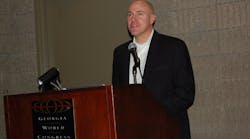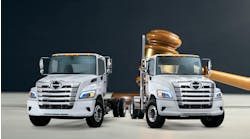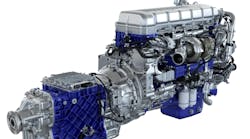ATLANTA. Since its introduction last October, the Endurant 12-speed automated manual transmission (AMT) is witnessing strong growth, according to Scott Davis, general manager of the Eaton Cummins Automated Transmission Technologies joint venture. It is now being positioned to expand into other trucking segments outside of the linehaul market – especially into the heavy haul 110,000 lb.-plus GCVW sector.
Right now, AMT penetration is roughly 30% into the heavy-haul market, Davis explained to Fleet Owner, and while he doesn’t expect it to reach the 70% to 80% penetration now being experienced in the linehaul segment, it could be 40% by next year due to a number of factors.
“What we see happening is more retirement of experienced drivers and more linehaul drivers moving into this [heavy haul] segment who don’t have the skills with a manual transmission,” Davis explained here during a press conference at the 2018 Technology & Maintenance Council (TMC) annual meeting. “The [AMT] technology is advancing and better integration [with engines] means smoother shifting plus more improved fuel economy. Think also about distraction: drivers must constantly think about shift points with a manual. Then there is fatigue issue: the mental and physical energy expended to manually shift gears, especially in stop-and-go environments. AMTs very good fit for that stop-and-go aspect of linehaul, that regional daycab operation.”
Since it went into production in October of last year, Davis said Eaton-Cummins has built and deployed 3,500 Endurant AMTs – “those numbers are probably already outdated as this his has been a very aggressive ramp up for us,” he said – and he expects to see it move into market segments currently covered by Eaton’s Fuller Advantage and UltraShift Plus AMT products.
“The key that the Endurant is a ‘purpose built’ AMT so we have optimized its architecture and reduced weight by several hundred pounds,” Davis explained. “AMTs also provide the technical foundation for telematics and predictive cruise, among other features. We can also get data on time spent in gear, how many times manual override occurs, etc. – that helps us calibrate shift schedules better. So if you operate in the Rocky Mountains, we can calibrate [the Endurant] differently versus operating on flat Florida highways. And we’re looking at over-the-air updates for calibration patterns just like engines; there is a lot of opportunity for that.”
He added that AMTs “are really going to help us with that transition to newer, younger, lesser-skilled drivers” as well as comply with greenhouse gas (GHG) regulations heavy truck targets expected to go into effect in 2021, 2024, and 2027.
“We’ll see a better result with [GHG] compliance by using AMTs – we’ll be better ability to meet the rules,” Davis stressed. “Integration gives you the ability for more consistent fuel consumption on routes, as well help in looking [at the road] ahead as get we get more advanced with smart coasting. Further out, we foresee predictive shifting at cruise to really optimize drive cycles.”
He also noted that one feedback point from customers concerned warranty protection for transmission “burnout,” which is something Eaton-Cummins is now offering for the Endurant.
Davis added that Eaton-Cummins also remains focused on delivering a “next-generation” Endurant product as well. “Our team is solely focused on automated transmissions; they know how to make the powertrain package work seamlessly as a single unit,” he explained. “You will see a whole pipeline of products as we work on advanced shifting – looking beyond transmission alone to include the entire powertrain as we seek ways to make shifts smoother and faster, including ways to execute more fuel-efficient features.”



